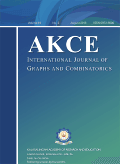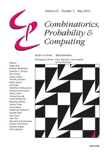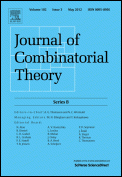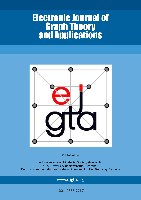
AKCE International Journal of Graphs and Combinatorics
Scope & Guideline
Exploring the Frontiers of Discrete Mathematics.
Introduction
Aims and Scopes
- Graph Theory:
A core area of focus, graph theory encompasses various properties, structures, and applications of graphs, including domination, coloring, and labeling. - Combinatorial Structures:
The journal explores combinatorial aspects related to graphs, such as hypergraphs and network structures, emphasizing their mathematical properties and applications. - Algebraic Graph Theory:
This area involves studying graphs through algebraic methods, including the examination of graph spectra, zero-divisor graphs, and their relationships with algebraic structures. - Game Theory and Graphs:
The integration of game theory concepts with graph structures is a notable theme, exploring strategic interactions modeled through graph representations. - Applications in Network Theory:
The journal often features research on practical applications of graph theory in network design, optimization, and communication systems.
Trending and Emerging
- Advanced Graph Labeling Techniques:
Recent papers have increasingly focused on sophisticated labeling methods, such as total Roman domination and antimagic labeling, highlighting their importance in both theoretical and practical applications. - Intersection of Graph Theory and Algebra:
The relationship between graph theory and algebraic structures, particularly zero-divisor graphs and spectral graph theory, has gained prominence, indicating a growing interest in algebraic methods within graph research. - Graph-Based Network Applications:
The application of graph theory in network scenarios, such as communication networks and social networks, has emerged as a significant trend, reflecting the real-world relevance of graph studies. - Metric Dimension and Domination in Graphs:
Research focusing on metric dimensions and various domination parameters has surged, pointing to a deeper exploration of how these concepts can optimize network structures. - Game-Theoretic Approaches to Graph Problems:
The integration of game theory with graph structures is becoming increasingly prevalent, indicating a trend towards the analysis of strategic interactions within graph-based frameworks.
Declining or Waning
- Classical Graph Algorithms:
Topics centered on traditional algorithms for graph traversal and basic manipulation have become less prominent, as researchers pursue more complex and application-driven methodologies. - Elementary Graph Properties:
Basic properties and characteristics of graphs, such as simple connectivity or degree sequences, are appearing less frequently, indicating a shift towards more intricate analyses. - Historical Perspectives on Graph Theory:
Papers that focus on historical or retrospective analyses of graph theory concepts have decreased, suggesting a move towards contemporary applications and developments.
Similar Journals

CANADIAN JOURNAL OF MATHEMATICS-JOURNAL CANADIEN DE MATHEMATIQUES
Fostering collaboration and innovation in mathematics.Canadian Journal of Mathematics - Journal Canadien de Mathématiques is a prestigious peer-reviewed journal published by Cambridge University Press, which aims to advance the field of mathematics through the dissemination of high-quality research articles. With its ISSN 0008-414X and E-ISSN 1496-4279, the journal plays a pivotal role in fostering mathematical research and collaboration. It has been recognized for its impactful contributions, currently holding a category quartile ranking of Q2 in Mathematics (miscellaneous) for 2023 and sits in the 66th percentile among its peers according to Scopus rankings. As the journal continues its convergence from its inception in 1994 through to 2024, it remains a vital resource for researchers, professionals, and students seeking to stay at the forefront of mathematical developments. The journal does not operate under an open access model, allowing for a curated collection of articles that adhere to rigorous academic standards.

Transactions on Combinatorics
Unlocking the Potential of Discrete MathematicsTransactions on Combinatorics is an esteemed academic journal dedicated to advancing the field of combinatorial mathematics. Published by UNIV ISFAHAN, VICE PRESIDENT RESEARCH & TECHNOLOGY, this journal has been an Open Access platform since 2012, ensuring that innovative research is freely available to scholars across the globe. With an ISSN of 2251-8657 and an E-ISSN of 2251-8665, it fosters a community for researchers to disseminate their findings within the realms of Computational Theory and Discrete Mathematics. The journal has been classified in the Q4 category for both its major fields in 2023 and holds notable Scopus rankings that reflect its growing influence in the academic community, despite currently being in the lower quartiles. The journal covers a diverse range of topics from theoretical frameworks to practical applications, making it a valuable resource for researchers, professionals, and students who are passionate about combinatorics. Addressed from DEPT PRINTING & PUBLISHING MAGAZINES, HEZAR-JARIB AVE, ISAFAHAN 81746-73441, IRAN, it stands as a beacon for collaborative research and knowledge sharing in this essential field.

Periodica Mathematica Hungarica
Advancing Mathematical Frontiers, One Study at a Time.Periodica Mathematica Hungarica is a prestigious academic journal published by Springer, focusing on the field of mathematics, with a particular emphasis on miscellaneous mathematical studies. Established in 1971, this journal has maintained its commitment to advancing mathematical research and its applications, making significant contributions over its converged years through 2024. With a Q2 ranking in the mathematics category as of 2023, it establishes itself as a vital resource within the mathematical community. Researchers and academics will find its inclusion in the Scopus database, ranking #189 out of 399 in general mathematics, indicative of its impact and relevance. Although it does not feature open access, the journal provides a wealth of high-quality peer-reviewed articles, thereby serving as an essential platform for the dissemination of innovative mathematical theories, methodologies, and findings. Engaging with the content of Periodica Mathematica Hungarica is crucial for anyone looking to stay at the forefront of mathematical research and development.

ARS Mathematica Contemporanea
Elevating Mathematical Discourse GloballyARS Mathematica Contemporanea, published by UP FAMNIT in Slovenia, stands as a pivotal journal within the fields of algebra, number theory, discrete mathematics, geometric topology, and theoretical computer science. Since its inception in 2011, this journal has consistently provided a rich platform for innovative research, garnering a commendable Q2 category ranking in various mathematical domains, including Algebra and Number Theory, and Geometry and Topology, showcasing its growing influence and prestige in the academic community. With an increasing Scopus rank—particularly notable in Algebra and Number Theory at the 71st percentile—ARS Mathematica Contemporanea is dedicated to publishing high-quality, peer-reviewed content that advances the frontiers of mathematical knowledge. The journal’s commitment to open access ensures that valuable research is readily available to scholars, practitioners, and students alike, fostering collaboration and dissemination of ideas across the globe. As it converges towards its dedicated timeline extending to 2024, ARS Mathematica Contemporanea remains a crucial resource for those engaged in mathematical research, presenting an array of theoretical and practical insights that define contemporary mathematical discourse.

Journal of Combinatorics
Championing High-Quality Research in Combinatorial TheoryJournal of Combinatorics is a premier academic journal dedicated to advancing the field of combinatorial theory and its applications. Published by INT PRESS BOSTON, INC, it aims to provide a robust platform for researchers, professionals, and students to disseminate their findings and engage with cutting-edge developments in combinatorics. With a focus on high-quality, peer-reviewed articles, the journal fosters rigorous mathematical discussions surrounding various facets of combinatorial structures, graph theory, design theory, and combinatorial optimization. Although currently not available as an Open Access journal, the Journal of Combinatorics plays a vital role in enriching the mathematical sciences and serves as an essential resource for academics seeking to stay updated with the latest trends in combinatorial research. By maintaining a commitment to excellence and innovation, this journal is indispensable for anyone looking to deepen their understanding in this critical area of study.

DISCRETE APPLIED MATHEMATICS
Advancing the Boundaries of Discrete Mathematics.DISCRETE APPLIED MATHEMATICS, published by ELSEVIER, is a premier journal dedicated to advancing the fields of Applied Mathematics, particularly focusing on Discrete Mathematics and Combinatorics. Since its inception in 1979, the journal has established itself as a vital resource for researchers and practitioners alike, achieving a commendable Q2 ranking in both applied and discrete mathematics categories as of 2023. With an ISSN of 0166-218X and an E-ISSN of 1872-6771, the journal serves an international audience by disseminating significant findings and fostering innovation in mathematical applications. Its Scopus ranking positions it notably within the top tier, ranking #23 out of 92 in Discrete Mathematics and Combinatorics, highlighting its impact in the academic community. Although the journal is not open access, it remains accessible through institutional subscriptions. Researchers, professionals, and students are encouraged to engage with the relevant and rigorous research published in this esteemed journal, as it plays a crucial role in shaping the future of mathematical sciences.

COMBINATORICS PROBABILITY & COMPUTING
Unraveling Complexities in Mathematics and ComputingCOMBINATORICS PROBABILITY & COMPUTING is a premier journal published by Cambridge University Press, focusing on the cutting-edge fields of combinatorics, probability, and their computational aspects. Established in 1992 and set to continue its impactful discourse through 2024, this journal holds a distinguished reputation, reflected in its Q1 ranking in applied mathematics, computational theory, and statistics, showcasing its pivotal role in advancing research in these areas. With an ISSN of 0963-5483 and an E-ISSN of 1469-2163, the journal welcomes high-quality papers that contribute to the theoretical foundations and practical applications of the disciplines. While it is not available as open access, its accessibility through institutional subscriptions ensures wide readership within academia. The journal is a vital resource for researchers, professionals, and students alike, providing a platform for innovative ideas and pioneering research that shapes the future of mathematics and computer science.

DISCRETE & COMPUTATIONAL GEOMETRY
Navigating the World of Geometry and Discrete SystemsDISCRETE & COMPUTATIONAL GEOMETRY is a prestigious journal published by Springer, specializing in the fields of computational geometry, discrete mathematics, and theoretical computer science. With its ISSN 0179-5376 and E-ISSN 1432-0444, this journal has established itself as a key resource for researchers and professionals, offering a platform for the dissemination of high-quality research from 1986 to 2024. Recognized for its impact in the academic community, it currently holds a Q2 ranking in several important categories, including Computational Theory and Mathematics, Discrete Mathematics and Combinatorics, Geometry and Topology, and Theoretical Computer Science. Although it is not an open-access journal, the rigorous peer-review process ensures that published articles meet the highest standards of scientific integrity and scholarship. With Scopus rankings reflecting its influence—placing it in the 72nd percentile for Geometry and Topology and 62nd for Discrete Mathematics—it serves as an essential reference for students and scholars seeking to deepen their understanding of complex geometric and combinatorial theories.

JOURNAL OF COMBINATORIAL THEORY SERIES B
Championing Excellence in Discrete MathematicsJOURNAL OF COMBINATORIAL THEORY SERIES B, published by Academic Press Inc., Elsevier Science, is an esteemed journal within the discipline of combinatorial theory, discrete mathematics, and theoretical computer science. With a rich history since its inception in 1971 and ongoing publication through 2025, this journal has established itself as a pillar in its field, currently holding Q1 category rankings in multiple areas including Computational Theory and Mathematics, Discrete Mathematics and Combinatorics, and Theoretical Computer Science. The journal features cutting-edge research and developments, attracting contributions from both established professionals and emerging scholars. Despite the absence of an open access option, the journal's strong impact reflected in its Scopus ranks—such as being number 16 out of 92 in Discrete Mathematics and Combinatorics (83rd percentile)—signifies its influential role in advancing knowledge and innovation. Researchers seeking to share impactful findings and connect with a vibrant academic community will find the JOURNAL OF COMBINATORIAL THEORY SERIES B an essential resource.

Electronic Journal of Graph Theory and Applications
Empowering researchers with open access to transformative insights.The Electronic Journal of Graph Theory and Applications, published by Institut Teknologi Bandung, is a prominent open-access journal since 2013, dedicated to the dynamic field of graph theory and its various applications. With an ISSN of 2338-2287 and an impressive categorization in 2023, the journal stands at Q2 in both Applied Mathematics and Discrete Mathematics and Combinatorics, reflecting its growing influence and recognition within the academic community. With its geographical base in Bandung, Indonesia, the journal seeks to provide researchers, professionals, and students with a platform to disseminate innovative research and applications, bridging gaps in both theoretical and practical domains. The Scopus rankings further establish its commitment to excellence, notable as Rank #54/92 in Discrete Mathematics and Combinatorics and Rank #473/635 in Applied Mathematics. By facilitating open access to high-quality research, the Electronic Journal of Graph Theory and Applications significantly contributes to advancing scholarship and encourages diverse perspectives within the field.